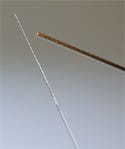Wireless data collected directly from patients during normal physical activities could enable the development of better knee implants
April 9, 2008
Originally Published MPMN April 2008
BREAKTHROUGHS
Miniature Sensor Detects Subtle Pressure Variations
|
A manufacturer claims that its FOP-F125, shown above on a 0.02-in. needle, is the smallest fiber-optic pressure sensor yet developed. |
Constructed with a diameter of 125 µm, a fiber-optic pressure sensor is the smallest of its kind, according to its manufacturer, Fiso Technologies Inc. The FOP-F125 sensor was developed to extend the reach of pressure-monitoring systems without sacrificing accuracy. Its small profile enables the sensor to be directly mounted at the tip of a fiber-optic cable, thus allowing the sensor to be positioned inside of the body at the exact point of measurement—potentially yielding a more accurate model than traditional pressure-monitoring systems. In addition, the sensor could be embedded in next-generation devices capable of accessing previously unreachable areas of the body.
Lumen pressure sensors can fail to provide the up-to-the-second accuracy needed to safely execute various surgical procedures, says Éric Pinet, principal scientist at Fiso. “With this new technology, the miniature sensor can be directly mounted at the catheter tip, so the real in situ pressure is being measured at all times,” he says. “With traditional systems, pressure measured through fluid-filled catheters can be inaccurate because it’s influenced by fluid friction, catheter compliance, or by the presence of tiny bubbles, which all create damping effects that distort fast-changing waveforms.”
Bulky pressure sensors can’t be mounted at the tip of catheters because the space is needed for other monitoring sensors or instruments. But the FOP-F125 is small enough that it does not present an impediment to other potential components. The company has developed a production process specifically to allow large-scale manufacturing of the sensor directly at the tip of glass optical fiber without using adhesive.
The main obstacle to achieving miniaturization was maintaining sensor accuracy, Pinet says. “Sensitivity of a pressure sensor is proportional to the diaphragm’s diameter to the power of four, so reducing the sensor’s diameter drastically decreases its sensitivity,” he explains. “Our advance was to replace the silicon diaphragm of our current generation of pressure sensor with a more flexible glass diaphragm and to reduce the thickness of the membrane so that the sensor could be both small and sufficiently sensitive.”
The sensor’s optical design makes it immune to the electromagnetic field and radio-frequency interferences often encountered in operating room settings and in close proximity to imaging systems. It also provides clear definition of complex pressure waveforms, such as human arterial blood pressure variations generated by heart valve closure. Suitable for invasive devices such as intracranial, intravascular, and intrauterine monitoring systems, the sensor’s responsiveness is also useful in determining pressure-curve characteristics at faster paces.
Fiso Technologies Inc., Quebec City, QC, Canada
www.fiso.com
Copyright ©2008 Medical Product Manufacturing News
You May Also Like


